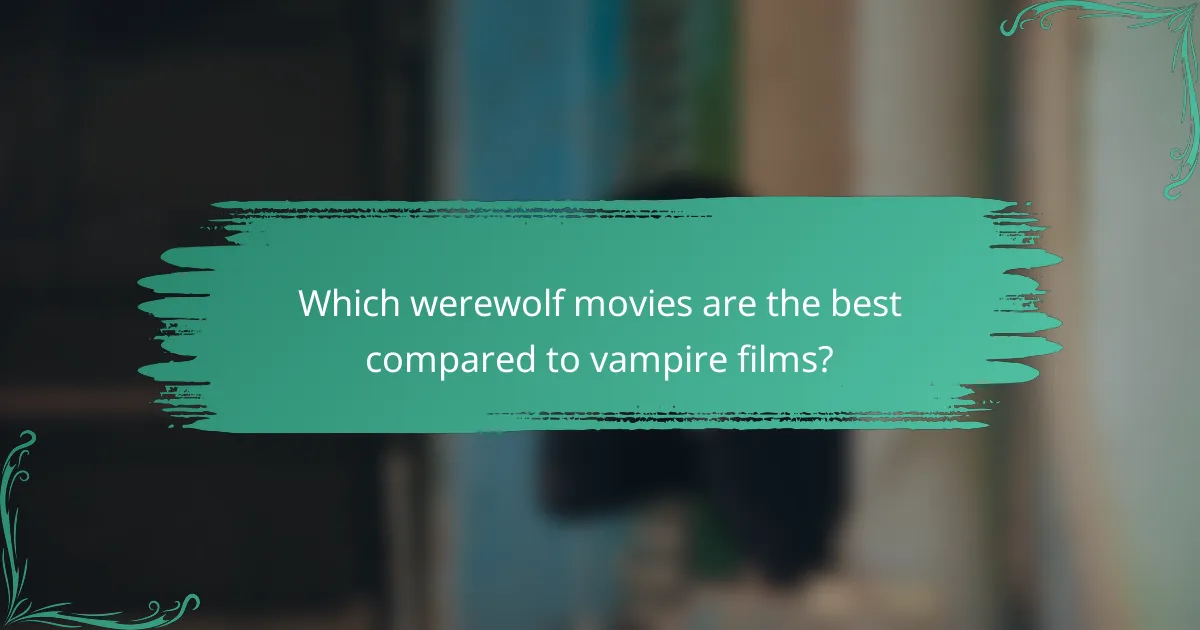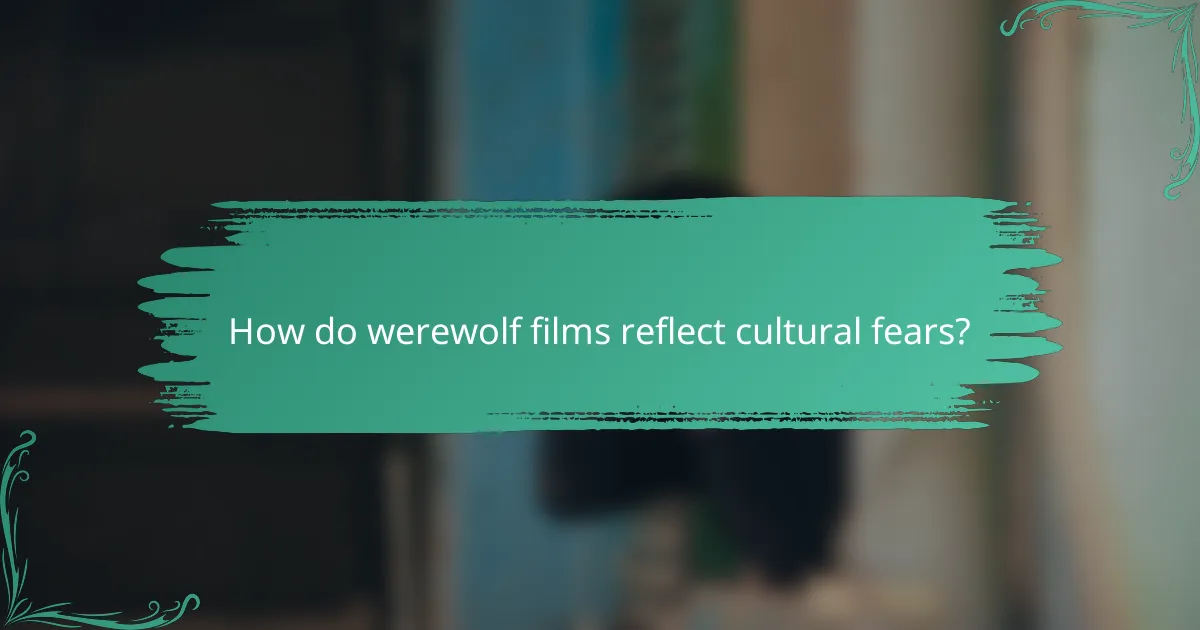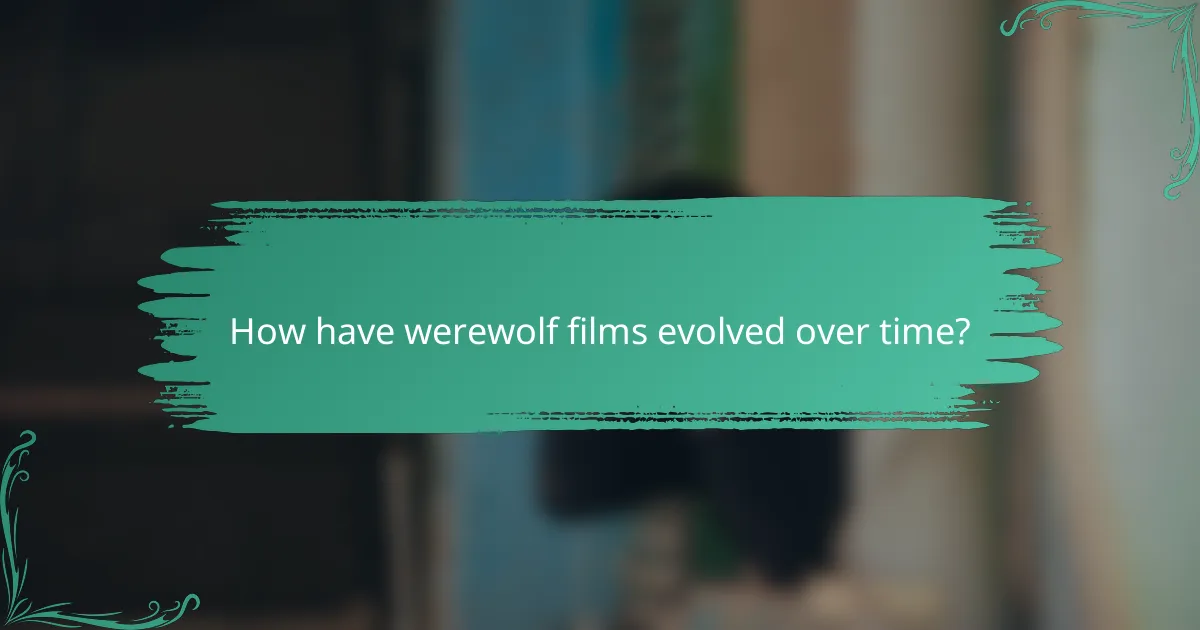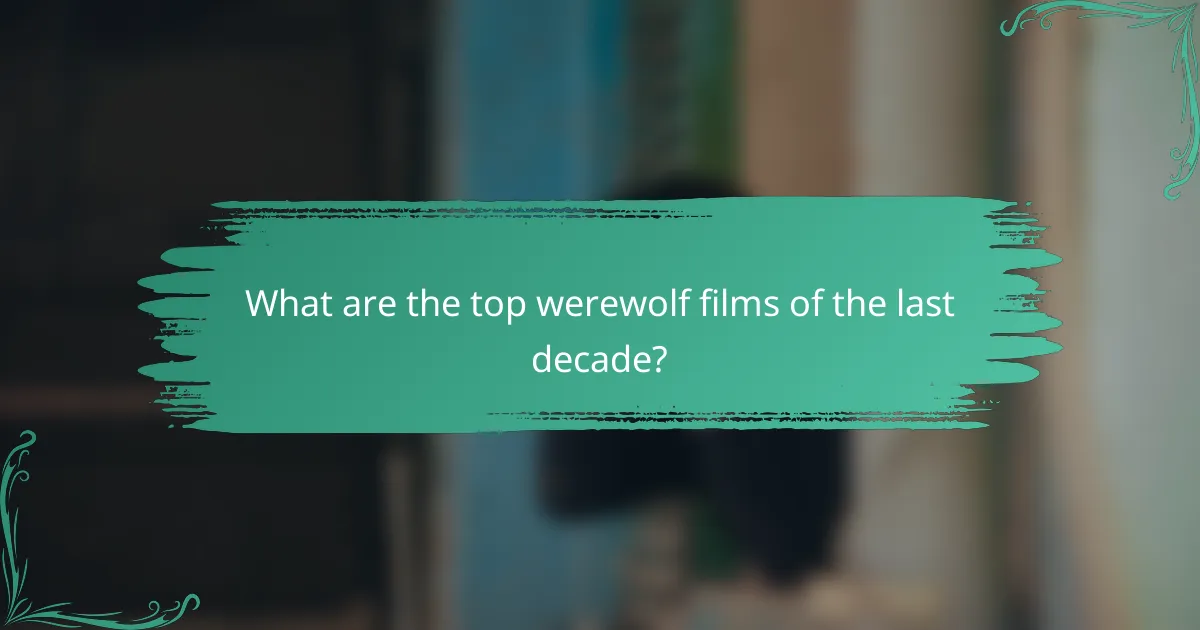When comparing werewolf movies to vampire films, distinct storytelling styles and thematic elements emerge, showcasing the unique strengths of each genre. Werewolf films emphasize transformation and the internal struggles of characters, reflecting deep-seated cultural fears and the duality of human nature, while vampire films often delve into themes of seduction and immortality.

Which werewolf movies are the best compared to vampire films?
When comparing werewolf movies to vampire films, several standout titles highlight the unique strengths of each genre. Notably, films like “Dog Soldiers” and “Let the Right One In” showcase distinct storytelling styles and thematic elements that appeal to different audiences.
Dog Soldiers vs. Let the Right One In
“Dog Soldiers” is a thrilling blend of horror and action, focusing on a group of soldiers battling werewolves in the Scottish Highlands. Its intense atmosphere and practical effects create a visceral experience that emphasizes survival against monstrous odds.
In contrast, “Let the Right One In” offers a more nuanced take on vampire lore, exploring themes of loneliness and friendship through the relationship between a young boy and a centuries-old vampire. This film’s emotional depth and haunting visuals set it apart from typical vampire narratives.
The Howling vs. What We Do in the Shadows
“The Howling” is a classic werewolf film that combines horror with social commentary, examining the primal instincts lurking within humanity. Its chilling atmosphere and innovative transformation scenes have made it a benchmark for werewolf cinema.
On the other hand, “What We Do in the Shadows” presents a comedic twist on vampire films, following a group of modern-day vampires navigating everyday life in New Zealand. Its humor and clever writing provide a refreshing contrast to the darker tones typically associated with vampire stories.
American Werewolf in London vs. Blade
“American Werewolf in London” is renowned for its groundbreaking special effects and dark humor, telling the story of a man grappling with his transformation into a werewolf. The film’s blend of horror and comedy has made it a beloved classic in the genre.
Conversely, “Blade” stands out as a superhero film that incorporates vampire mythology, featuring a half-vampire hero fighting against vampire overlords. Its action-packed sequences and stylish visuals have redefined vampire films, appealing to a broader audience beyond traditional horror fans.

What makes werewolf movies unique compared to vampire films?
Werewolf movies stand out from vampire films primarily due to their focus on transformation and the internal struggle of the characters. While vampires often embody seduction and immortality, werewolves highlight the primal instincts and the duality of human nature.
Transformation themes
Transformation is a central theme in werewolf films, often depicted as a painful and uncontrollable process. Characters typically undergo a physical change during a full moon, symbolizing the struggle between civilization and primal instincts. This theme contrasts sharply with vampires, who usually experience a more glamorous and voluntary transformation.
In werewolf narratives, the transformation often leads to a loss of control, resulting in violent behavior and moral dilemmas. This internal conflict can resonate with audiences, as it reflects the fear of losing one’s humanity.
Mythological origins
The mythological roots of werewolves can be traced back to ancient cultures, where they were often seen as cursed beings or manifestations of divine punishment. In contrast, vampire legends are frequently linked to folklore surrounding death and the afterlife. This difference in origins shapes the narratives and themes present in each genre.
For instance, werewolves are often associated with lunar cycles and nature, while vampires are tied to themes of immortality and seduction. This distinction influences the tone and atmosphere of the films, making werewolf stories more grounded in human fears and instincts.
Character development
Character development in werewolf films often focuses on the protagonist’s struggle with their dual identity. The transformation into a werewolf serves as a metaphor for personal demons and societal pressures, leading to rich character arcs. This contrasts with vampire films, where characters may embrace their vampiric nature more readily.
As werewolf characters grapple with their transformations, audiences witness their journey toward self-acceptance or tragic downfall. This depth of character exploration can create a more relatable experience for viewers, as they empathize with the struggle between human and beast.

How do werewolf films reflect cultural fears?
Werewolf films often mirror deep-seated cultural fears, particularly those related to transformation and the primal instincts lurking within humanity. These movies explore themes of identity, societal expectations, and the darker aspects of human nature, making them a compelling reflection of collective anxieties.
Fear of the unknown
The fear of the unknown is a central theme in werewolf films, as they depict the transformation from human to beast as a terrifying and unpredictable event. This change often symbolizes the anxiety surrounding what lies beyond the familiar, whether it be in nature, society, or within oneself. The unpredictability of the werewolf’s actions amplifies this fear, as audiences grapple with the idea that anyone could harbor a hidden, monstrous side.
For example, films like “An American Werewolf in London” illustrate how the unknown can lead to chaos and violence, highlighting the dread of losing one’s identity to an uncontrollable force. This theme resonates with viewers, reflecting societal fears about the unpredictability of life and the hidden dangers that may lurk beneath the surface.
Loss of control
Loss of control is another prominent fear depicted in werewolf films, where characters often struggle to maintain their humanity during their transformation. This theme resonates with audiences who fear losing autonomy over their actions and decisions, especially in moments of crisis. The werewolf serves as a metaphor for the primal urges that can overwhelm rational thought and social decorum.
In films like “The Wolfman,” the protagonist’s battle against his own nature illustrates the internal struggle many face when confronted with their darker impulses. This portrayal serves as a cautionary tale about the consequences of surrendering to one’s base instincts, reinforcing the fear of losing control in both personal and societal contexts.
Societal norms
Werewolf films often challenge societal norms by exploring the tension between conformity and individuality. The transformation into a werewolf frequently represents a rejection of societal expectations, allowing characters to embrace their true selves, albeit in a monstrous form. This conflict raises questions about the nature of identity and the pressures to conform to societal standards.
Movies like “Ginger Snaps” highlight how the werewolf metaphor can be used to critique societal norms, particularly regarding gender and adolescence. The characters’ transformations reflect the struggle against societal constraints, making the werewolf a powerful symbol of rebellion against conformity and the desire for self-acceptance.

What are the common tropes in werewolf movies?
Werewolf movies often feature several key tropes that define their narratives and character arcs. Common elements include transformations triggered by the full moon, a strong sense of pack mentality, and romantic subplots that complicate the characters’ lives.
Full moon transformations
The full moon is a central element in werewolf lore, serving as the trigger for transformations. During this time, characters typically undergo a dramatic change, shifting from human to wolf, which often symbolizes a loss of control and primal instincts. This trope emphasizes the struggle between humanity and bestial nature.
In many films, the transformation process is depicted with intense visual effects, showcasing the physical agony and emotional turmoil of the character. Examples include films like “An American Werewolf in London,” where the transformation is both painful and visually striking.
Pack mentality
Pack mentality is another hallmark of werewolf films, highlighting the importance of community among werewolves. This trope often portrays werewolves as social creatures that operate within a hierarchy, emphasizing loyalty, dominance, and the instinct to protect the pack. The dynamics within the pack can lead to conflicts and power struggles.
Films like “The Howling” illustrate how pack mentality influences behavior, often leading to group hunts and collective decision-making. This aspect can also create tension between individual desires and the responsibilities to the pack.
Romantic subplots
Romantic subplots frequently intertwine with the werewolf narrative, adding emotional depth and complexity. These relationships often face challenges due to the werewolf’s dual nature, creating tension between love and the threat posed by the beast within. The romance may serve as a catalyst for character development.
In movies such as “Ginger Snaps,” the romantic angle complicates the protagonist’s transformation, as love interests may either support or hinder their struggle against their werewolf identity. This trope highlights the personal stakes involved in the werewolf’s journey.

How have werewolf films evolved over time?
Werewolf films have significantly transformed from their early classic horror roots to contemporary interpretations that explore deeper themes and character complexities. This evolution reflects changes in societal attitudes, filmmaking technology, and audience expectations.
Classic horror to modern interpretations
Classic werewolf films, such as “The Wolf Man” from the 1940s, focused on the horror of transformation and the loss of control. These films often portrayed werewolves as tragic figures, embodying the struggle between humanity and primal instincts.
In contrast, modern interpretations like “Dog Soldiers” and “The Howling” delve into psychological and social themes, often exploring identity and the nature of monstrosity. This shift allows filmmakers to use werewolves as metaphors for broader human experiences, such as fear, isolation, and the duality of human nature.
Influence of technology in filmmaking
Advancements in technology have greatly influenced the portrayal of werewolves in films. Early special effects relied on practical makeup and animatronics, which created a tangible sense of horror but limited the visual possibilities. Today, CGI allows for more dynamic transformations and realistic depictions of werewolves, enhancing the overall viewing experience.
However, the use of technology also presents challenges. Over-reliance on CGI can lead to a lack of emotional connection with the characters. Filmmakers must balance technological innovation with strong storytelling to create impactful werewolf narratives that resonate with audiences.

What are the top werewolf films of the last decade?
The last decade has seen a resurgence of werewolf films, with several standout titles that have captivated audiences. Notable entries include a mix of horror, drama, and even comedy, showcasing the versatility of werewolf lore in modern cinema.
Notable Titles
Some of the most acclaimed werewolf films from the past ten years include “The Wolf of Snow Hollow,” “Werewolves Within,” and “Howl.” Each of these films brings a unique perspective to the werewolf mythos, blending elements of suspense, humor, and social commentary.
For example, “The Wolf of Snow Hollow” combines dark comedy with a murder mystery, while “Werewolves Within” offers a satirical take on community dynamics during a werewolf attack. These films highlight how werewolf narratives can be both entertaining and thought-provoking.
Key Themes
Common themes in recent werewolf films include identity, transformation, and the struggle between humanity and primal instincts. These films often explore the metaphorical implications of becoming a werewolf, reflecting inner turmoil and societal pressures.
Additionally, many films use the werewolf as a vehicle to discuss broader issues, such as isolation, fear of the unknown, and the consequences of unchecked aggression. This thematic depth adds layers to the viewing experience, making them more than just horror flicks.
Audience Reception
Audience reception of werewolf films has varied, with some achieving critical acclaim while others have garnered mixed reviews. Films like “The Wolf of Snow Hollow” received praise for their innovative storytelling and character development, while others struggled to resonate with viewers.
Overall, the werewolf genre continues to evolve, attracting both horror enthusiasts and casual viewers. The blend of traditional horror elements with contemporary storytelling keeps the genre fresh and engaging.
